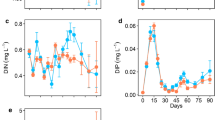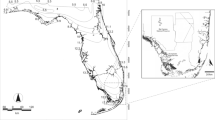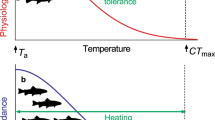Abstract
Hydrologic and thermal regimes vary along the upstream-to-downstream river continuum and drive the assembly of fish communities. The metabolic cold adaptation (MCA) hypothesis predicts that faster development is adaptive for species exposed to shorter growing seasons. Whether gradients of hydrologic variability and seasonal thermal regime associated with the river continuum operate as environmental filters on species with differing developmental rates remains an untested mechanism of community assembly. We analyzed daily records of stream discharge and modeled stream temperatures to quantify these two gradients of abiotic harshness in Kansas, USA. We then used laboratory experiments to compare temperature-dependent larval development rates among three congeneric cyprinid species that are most abundant in small tributaries (Pimephales promelas), medium tributaries (P. notatus), or river mainstems (P. vigilax). Growing season duration increased with stream size, with temperature exceedance thresholds of 22 and 26 °C lasting 1.4 and 270 times longer, respectively, in eighth order river mainstems compared to second order tributaries. The frequency of small flood pulses within the growing season peaked in mid-order streams, whereas the frequency of large flood pulses within the growing season peaked in low-order streams. Larval development rates increased with incubation temperature, but did not differ predictably among species. These findings, when viewed alongside a companion study, suggest that thermal adaptation and not MCA explains the replacements of Pimephales species along the river continuum. The prominent upstream-to-downstream gradient in growing season duration highlights the need for studies on the evolutionary and ecological significance of this infrequently explored characteristic of the river continuum.






Similar content being viewed by others
References
Addo‐Bediako A, Chown SL, Gaston KJ (2002) Metabolic cold adaptation in insects: a large‐scale perspective. Funct Ecol 16:332–338. doi:10.1046/j.1365-2435.2002.00634.x
Angilletta MJ (2006) Estimating and comparing thermal performance curves. J Therm Biol 31:541–545. doi:10.1016/j.jtherbio.2006.06.002
Angilletta MJ (2009) Thermal adaptation: a theoretical and empirical synthesis. Oxford University Press, Oxford
Baumann H, Conover D (2011) Adaptation to climate change: contrasting patterns of thermal-reaction-norm evolution in Pacific versus Atlantic silversides. Proc R Soc B 278:2265–2273. doi:10.1098/rspb.2010.2479
Blanck A, Lamouroux N (2007) Large‐scale intraspecific variation in life‐history traits of European freshwater fish. J Biogeogr 34:862–875. doi:10.1111/j.1365-2699.2006.01654.x
Braasch ME, Smith PW (1965) Relationships of the topminnows Fundulus notatus and Fundulus olivaceus in the Upper Mississippi River Valley. Copeia 1965:46–53, http://www.jstor.org/stable/1441238
Braaten PJ, Guy CS (2002) Life history attributes of fishes along the latitudinal gradient of the Missouri River. Trans Am Fish Soc 131:931–945. doi:10.1577/1548-8659(2002)131<0931:LHAOFA>2.0.CO;2
Briere JF, Pracros P, Le Roux AY, Pierre JS (1999) A novel rate model of temperature-dependent development for arthropods. Environ Entomol 28:22–29. doi:10.1093/ee/28.1.22
Brown JH, Gillooly JF, Allen AP, Savage VM, West GB (2004) Toward a metabolic theory of ecology. Ecology 85:1771–1789. doi:10.1890/03-9000
Cade BS (2006) National hydrologic assessment tool (NATHAT). U.S. Geological Survey
Caissie D, El-Jabi N, Satish MG (2001) Modelling of maximum daily water temperatures in a small stream using air temperatures. J Hydrol 251(1):14–28
Carmona-Catot G, Benito J, Garcia-Berthou E (2011) Comparing latitudinal and upstream-downstream gradients: life history traits of invasive mosquitofish. Divers Distrib 17:214–224. doi:10.1111/j.1472-4642.2011.00743.x
Chivers DP, Kiesecker JM, Marco A, Devito J, Anderson MT, Blaustein AR (2001) Predator‐induced life history changes in amphibians: egg predation induces hatching. Oikos 92:135–142. doi:10.1034/j.1600-0706.2001.920116.x
Clarke A (2003) Costs and consequences of evolutionary temperature adaptation. Trends Ecol Evol 18:573–581. doi:10.1016/j.tree.2003.08.007
Conover DO (1992) Seasonality and the scheduling of life history at different latitudes. J Fish Biol 41:161–178. doi:10.1111/j.1095-8649.1992.tb03876.x
Conover DO, Present TMC (1990) Countergradient variation in growth-rate: compensation for length of the growing-season among Atlantic silversides from different latitudes. Oecologia 83:316–324. doi:10.1007/BF00317554
Cross FB, Collins JT (1995) Fishes in Kansas, 2nd edn. University of Kansas, Lawrence
Edds DR (1993) Fish assemblage structure and environmental correlates in Nepal’s Gandaki River. Copeia 1993:48–60. doi:10.2307/1446294
Falcone JA, Carlisle DM, Wolock DM, Meador MR (2010) GAGES: a stream gage database for evaluating natural and altered flow conditions in the conterminous United States. Ecology 91:621. doi:10.1890/09-0889.1
Fausch KD, Nakano S, Ishigaki K (1994) Distribution of two congeneric charrs in streams of Hokkaido Island, Japan: considering multiple factors across scales. Oecologia 100:1–12. doi:10.1007/BF00317124
Fischer K, Kölzow N, Höltje H, Karl I (2011) Assay conditions in laboratory experiments: is the use of constant rather than fluctuating temperatures justified when investigating temperature-induced plasticity? Oecologia 166:23–33. doi:10.1007/s00442-011-1917-0
Fleming IA, Gross MR (1990) Latitudinal clines: a trade-off between egg number and size in Pacific salmon. Ecology 71:2–11. doi:10.2307/1940241
Fullerton AH, Torgersen CE, Lawler JJ, Faux RN, Steel EA, Beechie TJ, Ebersole JL, Leibowitz SG (2015) Rethinking the longitudinal stream temperature paradigm: region‐wide comparison of thermal infrared imagery reveals unexpected complexity of river temperatures. Hydrol Process 29(22):4719–4737
Gardiner NM, Munday PL, Nilsson GE (2010) Counter-gradient variation in respiratory performance of coral reef fishes at elevated temperatures. PLoS One 5:e13299. doi:10.1371/journal.pone.0013299
Gillooly JF, Brown JH, West GB, Savage VM, Charnov EL (2001) Effects of size and temperature on metabolic rate. Science 293:2248–2251. doi:10.1126/science.1061967
Gordon ND, McMahon TA, Finlayson BL, Gippel CJ, Nathan RJ (2004) Stream hydrology: an introduction for ecologists, 2nd edn. John Wiley and Sons Ltd, Chichester
Grossman GD, Ratajczak RE, Farr MD, Wagner CM, Petty JT (2010) Why there are more fish downstream. In: Gido KB, Jackson DA (eds) Community ecology of stream fishes: concepts, approaches, and techniques. American Fisheries Society Symposium 73, Bethesda, p 63–81
Guisan A, Edwards TC, Hastie T (2002) Generalized linear and generalized additive models in studies of species distributions: setting the scene. Ecol Model 157:89–100. doi:10.1016/S0304-3800(02)00204-1
Heming TA (1982) Effects of temperature on utilization of yolk by chinook salmon (Oncorhynchus tshawytscha) eggs and alevins. Can J Fish Aquat Sci 39:184–190. doi:10.1139/f82-021
Hodgkinson I (2005) Terrestrial insects along elevation gradients: species and community responses to altitude. Biol Rev 80:489–513. doi:10.1017/S1464793105006767
Huet M (1959) Profiles and biology of western European streams as related to fish management. Trans Am Fish Soc 88:155–163. doi:10.1577/1548-8659(1959)88[155:PABOWE]2.0.CO;2
Ibañez C, Belliard J, Hughes RM, Irz P, Kamdem‐Toham A, Lamouroux N, Tedesco PA, Oberdorff T (2009) Convergence of temperate and tropical stream fish assemblages. Ecography 32:658–670. doi:10.1111/j.1600-0587.2008.05591.x
Kamler E (2002) Ontogeny of yolk-feeding fish: an ecological perspective. Rev Fish Biol Fish 12:79–103. doi:10.1023/A:1022603204337
Kamler E (2005) Parent–egg–progeny relationships in teleost fishes: an energetics perspective. Rev Fish Biol Fish 15:399–421. doi:10.1007/s11160-006-0002-y
Maheu A, Poff NL, St‐Hilaire A (2015) A classification of stream water temperature regimes in the conterminous USA. River Res Appl. doi:10.1002/rra.2906
Mims MC, Olden JD (2012) Life history theory predicts fish assemblage response to hydrologic regimes. Ecology 93:35–45. doi:10.1890/11-0370.1
Neuheimer AB, Taggart, CT (2007) The growing degree-day and fish size-at-age: the overlooked metric. Can J Fish Aquat Sci 64(2):375–385. doi:10.1007/s10641-017-0577-2
Perkin JS, Gido KB, Costigan KH, Daniels MD, Johnson ER (2014) Fragmentation and drying ratchet down Great Plains stream fish diversity. Aquat Conserv 25:639–655. doi:10.1002/aqc.2501
Pflieger WL (1997) The fishes of Missouri. Missouri Department of Conservation
Poff NL (1997) Landscape filters and species traits: towards mechanistic understanding and prediction in stream ecology. J N Am Benthol Soc 391–409. doi:10.2307/1468026
Poff NL, Allan JD (1995) Functional organization of stream fish assemblages in relation to hydrological variability. Ecology 76:606–627. doi:10.2307/1941217
Poff NL, Allan JD, Bain MB, Karr JR, Prestegaard KL, Richter BD, Sparks RE, Stromberg JC (1997) The natural flow regime. Bioscience 47:769–784. doi:10.2307/1313099
Poff NL, Olden JD, Pepin DM, Bledsoe BP (2006) Placing global stream flow variability in geographic and geomorphic contexts. River Res Appl 22:149–166. doi:10.1002/rra.902
R Development Core Team (2016) R: a language and environment for statistical computing. R Foundation for Statistical Computing, Vienna
Rahel FJ, Hubert WA (1991) Fish assemblages and habitat gradients in a Rocky Mountain–Great Plains stream: biotic zonation and additive patterns of community change. Trans Am Fish Soc 120:319–332. doi:10.1577/1548-8659(1991)120<0319:FAAHGI>2.3.CO;2
Richter BD, Baumgartner JV, Powell J, Braun DP (1996) A method for assessing hydrologic alteration within ecosystems. Conserv Biol 10:1163–1174. doi:10.1046/j.1523-1739.1996.10041163.x
Schaefer JF, Ryan A (2006) Developmental plasticity in the thermal tolerance of zebrafish Danio rerio. J Fish Biol 69:722–734. doi:10.1111/j.1095-8649.2006.01145.x
Schaefer J, Walters A (2010) Metabolic cold adaptation and developmental plasticity in metabolic rates among species in the Fundulus notatus species complex. Funct Ecol 24:1087–1094. doi:10.1111/j.1365-2435.2010.01726.x
Schaefer J, Duvernell D, Kreiser B (2011) Shape variability in topminnows (Fundulus notatus species complex) along the river continuum. Biol J Linn Soc 103:612–621. doi:10.1111/j.1095-8312.2011.01660.x
Schultz ET, Reynolds KE, Conover DO (1996) Countergradient variation in growth among newly hatched Fundulus heteroclitus: geographic differences revealed by common-environment experiments. Funct Ecol 10:366–374. doi:10.2307/2390285
Taniguchi Y, Nakano S (2000) Condition-specific competition: implications for the altitudinal distribution of stream fishes. Ecology 81:2027–2039. doi:10.1890/0012-9658(2000)081[2027:CSCIFT]2.0.CO;2
Taniguchi Y, Rahel FJ, Novinger DC, Gerow KG (1998) Temperature mediation of competitive interactions among three fish species that replace each other along longitudinal stream gradients. Can J Fish Aquat Sci 55:1894–1901. doi:10.1139/f98-072
Taylor CM, Lienesch PW (1996) Regional parapatry of the congeneric cyprinids Lythrurus snelsoni and L. umbratilus: species replacement along a complex environmental gradient. Copeia 1996:493–497, http://www.jstor.org/stable/1446875
Troia MJ, Gido KB (2014) Towards a mechanistic understanding of fish species niche divergence along a river continuum. Ecosphere 5:1–18. doi:10.1890/ES13-00399.1
Troia MJ, Gido KB (2015) Functional strategies drive community assembly of stream fishes along environmental gradients and across spatial scales. Oecologia 177:545–559. doi:10.1007/s00442-014-3178-1
Troia MJ, Denk MA, Gido KB (2015a) Temperature-dependent performance as a driver of warmwater fish species replacement along the river continuum. Can J Fish Aquat Sci. doi:10.1139/cjfas-2015-0094
Troia MJ, Williams LR, Williams MG, Ford NB (2015b) The process domains concept as a framework for fish and mussel habitat in a coastal plain river of southeastern North America. Ecol Eng 75:484–496. doi:10.1016/j.ecoleng.2014.12.016
Vannote RL, Minshall GW, Cummins KW, Sedell JR, Cushing CE (1980) The river continuum concept. Can J Fish Aquat Sci 37:130–137. doi:10.1139/f80-017
Violle C, Navas ML, Vile D, Kazakou E, Fortunel C, Hummel I, Garnier E (2007) Let the concept of trait be functional! Oikos 116:882–892. doi:10.1111/j.0030-1299.2007.15559.x
Vøllestad LA, Lillehammer T (2000) Individual variation in early life-hostory traits in brown trout. Ecol Freshw Fish 9:242–247. doi:10.1111/j.1600-0633.2000.eff090407.x
Vonesh JR, Bolker BM (2005) Compensatory larval responses shift trade-offs associated with predator-induced hatching plasticity. Ecology 86:1580–1591. doi:10.1890/04-0535
Wedekind C (2002) Induced hatching to avoid infectious egg disease in whitefish. Curr Biol 12:69–71. doi:10.1016/S0960-9822(01)00627-3
Winemiller KO, Rose KA (1992) Patterns of life-history diversification in North American fishes: implications for population regulation. Can J Fish Aquat Sci 49:2196–2218. doi:10.1139/f92-242
Xenopoulos MA, Lodge DM (2006) Going with the flow: using species-discharge relationships to forecast losses in fish biodiversity. Ecology 87:1907–1914. doi:10.1890/0012-9658(2006)87[1907:GWTFUS]2.0.CO;2
Acknowledgements
The authors thank Nate Cathcart, Michael Denk, Sky Hedden, Emily Johnson, Kevin Kirkbride, Josh Perkin, Dustin Shaw, Trevor Starks, Allison Veach, James Whitney, and Rebecca Zheng for field and laboratory assistance. Many private land owners for provided access to streams as well as the Tallgrass Prairie National Preserve, Kansas Department of Wildlife Parks and Tourism, and Joe and Alison Gerken for substantial stream access. The authors thank Jake Schaefer for advice on experimental design and data analysis as well as John Blair and Conservation Fisheries, Inc. for use of equipment and laboratory facilities. This research was funded by the National Science Foundation (DEB#1311183), the Southwestern Association of Naturalists, Prairie Biotic Research Inc., and the Kansas Academy of Science. Brood stocks were collected under the permission of the Kansas Department of Wildlife Parks and Tourism (permit #SC-089-2014) and housed and spawned under the permission of the Kansas State University Institutional Animal Care and Use Committee (permit #2996). This is publication #17-208-J from the Kansas Agricultural Experiment Station. The authors have no conflicts of interest to declare.
Author information
Authors and Affiliations
Corresponding author
Rights and permissions
About this article
Cite this article
Troia, M.J., Gido, K.B. Testing metabolic cold adaptation as a driver of warm-water fish species replacement along the river continuum. Environ Biol Fish 100, 265–279 (2017). https://doi.org/10.1007/s10641-017-0577-2
Received:
Accepted:
Published:
Issue Date:
DOI: https://doi.org/10.1007/s10641-017-0577-2




